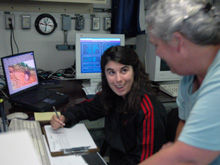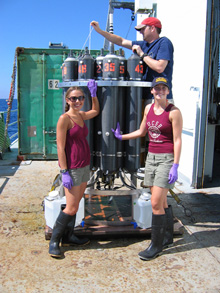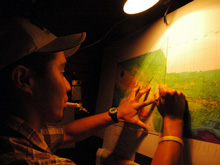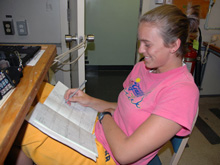
Undergraduate student Sarah White helps collect data during a CTD cast. Click image for larger view and image credit.

Monica Heintz and Christine Desautels work with research technician Nathan Buck to extract water samples from a recently recovered CTD/Niskin Rosette cast containing plume water samples. Click image for larger view and image credit.
A Journey of Personal Discovery
December 18, 2005
Sarah White
Undergraduate Student
University of California, Santa Barbara
I’ve been looking forward to this trip for a long time. I first heard about it almost a year ago, from my Earth Science department advisor at UCSB. It sounded like a great way to fulfill the research requirement for my major, Earth Systems Science. It would also be a chance to try something totally new – living at sea – and I’d get to see the famed Galapagos Islands.
My friends were all envious.
First, I took an overview class on hydrothermal systems from Dr. Rachel Haymon, Chief Scientist on the expedition and a geology professor at UCSB. Hydrothermal systems are the way in which seawater interacts with newly created seafloor at or near the mid-ocean ridge. Water percolates down into the hot, porous rock, reacts with and alters the minerals there, and exits the system very hot and laden with strange elements and ions.
Of course, it’s much more complicated than that, as I learned in the class. There was no textbook – instead, class time was spent reading and discussing scientific papers on various subtopics, including hydrothermal vent biota, fluid chemistry, magma supply to the ridge, and so on.
This turned out to be excellent preparation for the next class, also taught by Dr. Haymon, in which we read and discussed papers that were specifically about our study area on the Galapagos Spreading Center.
What interested me most was the question of what determines vent occurrence and distribution. Which is more important – how hot the underlying rock is (which accelerates the movement of water through the system), or how porous the rock is (which controls how much water can move through the system)?
It turns out that one of the main purposes of the expedition is to answer this question.
I came aboard three days ago hoping to see what conducting real research feels like. I’m in my last year of undergraduate study, and like many of my friends I’m trying to decide if graduate school is the right thing for me. I know I enjoy taking classes, but actually doing research – the main component of graduate work – is relatively uncharted territory for me. Doing research always sounded so exciting when I heard about it on PBS science specials as a child.
However, as I’m beginning to learn already, real life isn’t always like a PBS science special. True research requires a great deal of both patience and motivation. While on board this cruise, our roles as students will initially start out small, taking part in routine data logging and tasks. As more and more data flows in, we will learn how our small role fits into the larger picture by becoming increasingly engaged in data analysis and the creative process of understanding what we are seeing.
After we return from the cruise, the eight other UCSB students and I will take a follow-up class from Dr. Ken MacDonald, another Principal Investigator on the trip and UCSB geology professor. He will break us up into small groups to work on various short-term projects concerning the data we will have collected. This is what I’m both excited and apprehensive about. Will I have found an interesting project by then? Will I have the resolve to carry it through to completion? Will it be fun? Or tedious? My time on board over the next three weeks should shed some light on these questions.
GalAPAGoS: Where Ridge Meets Hotspot will be sending reports from Dec 3 - Jan 10. Please check back frequently for additional logs from this expedition.
Sign up for the Ocean Explorer E-mail Update List.






























